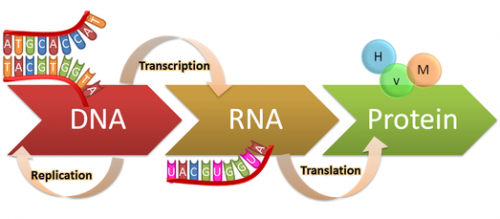Researchers study organisms’ genomes using a process called ribonucleic acid sequencing (RNA-seq), which gives a holistic picture of what genes that organism’s cells are expressing. Recently, Yale PhD candidate Jeremy Schofield and colleagues working in Associate Professor Matthew Simon’s lab introduced a new RNA-seq method called TimeLapse-seq. Published in Nature Methods, this technique reveals changes in RNA dynamics over a given time period. Previous techniques looking at changes over time required large amounts of RNA molecules for sequencing, but this new method requires exponentially less material.
RNA-seq relies on the manipulation of biology’s central dogma: DNA is transcribed into RNA and RNA is translated into proteins, which effect change within an organism. RNA is the essential intermediate in this chain. However, only certain fragments of an organism’s DNA are transcribed into RNA at any given time, so RNA-seq allows researchers to identify relative abundances of RNA molecules and thus which genes are currently expressed. TimeLapse-seq allows researchers to track changes in RNA levels over time, which could occur from development or stress responses. The process behind TimeLapse-seq mirrors RNA-seq, with one additional step: labeling of new RNAs to distinguish them from old RNAs. Other research groups perform labeling for similar purposes, but this technology is the first to make the label visible on a sequencer.
RNA-seq involves converting an organism’s RNA back into single stranded DNA, but in TimeLapse-seq metabolic labeling occurs before this reverse transcription. Researchers start by giving a cell of interest 4-thiouridine, a sulfur-containing modified version of uridine, one of the four nucleotides that comprise RNA strands. The cell then uses some 4-thiouridine to make new RNA. To distinguish between the old RNA and the new RNA, Schofield and the Simon lab developed a way to mutate the 4-thiouridine nucleotide on new RNAs. The sulfur in 4-thiouridine is oxidized and an amine is substituted into the ring, changing 4-thiouridine into a molecule similar to cytidine, a different RNA nucleotide (Figure 1)]. This mutation can then appear on a sequencer.
After the cell has been treated with 4-thiouridine, the mixture of old and new RNA is sequenced. Researchers then reference standard already-sequenced genomes to identify where nucleotide mutations occurred. As a result, using TimeLapse-seq, researchers can estimate how much new RNA was made from a specific gene during the time period of interest. One limitation, however, is that the technique does not indicate when the new RNA was made over the specified time period.
Previous temporal sequencing techniques required tens to hundreds of micrograms of RNA. TimeLapse-seq only requires nanograms or picograms of RNA material because it does not involve biochemical enrichment, a technique used to concentrate RNA for further analysis. In terms of cell numbers, previous techniques required at least 1 million cells, whereas TimeLapse-seq can use just 10,000 cells.
This technique allows Schofield and others to look to new horizons. “TimeLapse-seq opens up opportunities to look at biological systems that weren’t scalable before,” he said. For example, researchers can use TimeLapse-seq to study how different mouse tissues react to drugs, specifically looking at changes in RNA populations at different time periods after receiving the drug. This would not have been possible with previous techniques.
The Simon lab is working to extend the TimeLapse-seq technology to other kinds of molecules, and they are beginning to collaborate with groups studying systems of small sample size that can benefit from this technique. Thanks to of TimeLapse-seq, questions that Jeremy and his colleagues may never have stumbled upon themselves can now play a bigger role in the scientific conversation.

